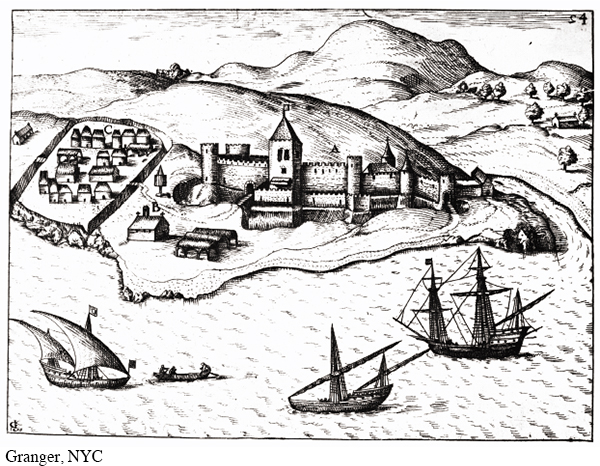Portugal Pursues Long-Distance Trade
Cut off from the Mediterranean by Italian city-states and Muslim rulers in North Africa, Portugal looked toward the Atlantic. Although a tiny nation, Portugal benefited from the leadership of its young prince, Henry, who launched explorations of the African coast in the 1420s, hoping to find a passage to India via the Atlantic Ocean. Prince Henry—known as Henry the Navigator—gathered information from astronomers, geographers, mapmakers, and craftsmen in the Arab world and recruited Italian cartographers and navigators along with Portuguese scholars, sailors, and captains. He then launched a systematic campaign of exploration, observation, shipbuilding, and long-distance trade that revolutionized Europe and shaped developments in Africa and the Americas.
Prince Henry and his colleagues developed ships known as caravels—vessels with narrow hulls and triangular sails that were especially effective for navigating the coast of West Africa. His staff also created state-of-the-art maritime charts, maps, and astronomical tables; perfected navigational instruments; and mastered the complex wind and sea currents along the African coast. Soon Portugal was trading in gold, ivory, and slaves from West Africa.
In 1482 Portugal built Elmina Castle, a trading post and fort on the Gold Coast (present-day Ghana). Further expeditions were launched from the castle; and five years later, a fleet led by Bartolomeu Dias rounded the Cape of Good Hope, on the southernmost tip of Africa. This feat demonstrated the possibility of sailing directly from the Atlantic to the Indian Ocean. Vasco da Gama followed this route to India in 1497, returning to Portugal in 1499, his ships laden with valuable cinnamon and pepper.

By the early sixteenth century, Portuguese traders had wrested control of the India trade from Arab fleets. They established fortified trading posts at key locations on the Indian Ocean and extended their expeditions to Indonesia, China, and Japan. Within a decade, the Portuguese had become the leaders in international trade. Spain, England, France, and the Netherlands competed for a share of this newfound wealth by developing long-distance markets that brought spices, ivory, silks, cotton cloth, and other luxury goods to Europe.
With expanding populations and greater agricultural productivity, European nations developed more efficient systems of taxation, built larger military forces, and adapted gunpowder to new kinds of weapons. The surge in population provided the men to labor on merchant vessels, staff forts, and protect trade routes. More people began to settle in cities, which grew into important commercial centers. Slowly, a form of capitalism based on market exchange, private ownership, and capital accumulation and reinvestment developed across much of Europe.
African slaves were among the most lucrative goods traded by European merchants. Slavery had been practiced in Europe, America, Africa, and other parts of the world for centuries. But in most times and places, slaves were captives of war or individuals sold in payment for deaths or injuries to conquering enemies. Under such circumstances, slaves generally retained some legal rights, and bondage was rarely permanent and almost never inheritable. With the advent of large-scale European participation in the African slave trade, however, the system of bondage began to change, transforming Europe and Africa and eventually the Americas.
Exploring American HistoriesPrinted Page 13
Exploring American Histories Value EditionPrinted Page 11
Chapter Timeline